The price trend of nitrogen fertilisers - such as nitric acid, urea, and CAN (calcium ammonium nitrate) - is mainly driven by gas and ammonia prices. The gas price showed an upward trend in recent months, but has recently fallen again. Ammonia, on the other hand, is still rising sharply in price, according to Yara.
Since the beginning of the conflict in the Middle East, the price of urea has increased by more than 30%. This is partly due to the unstable situation in Iran and reduced gas supplies from Israel to Egypt. As a result, nitrogen fertilizer prices are expected to be adjusted in the coming quarter.
Phosphorus fertilisers (P)
Phosphorus-based fertilizers are mainly derived from phosphoric acid, which is produced by reacting phosphate rock with sulfuric acid. The price of sulfuric acid has risen significantly in recent months, although it now appears to have reached a peak.
Prices of related products such as MAP (monoammonium phosphate) and DAP (diammonium phosphate) have also surged, largely due to an 89% drop in Chinese exports. This combination of factors will lead to price adjustments for phosphorus-based fertilizers starting in the third quarter.
Potassium-based fertilisers (K)
In greenhouse horticulture, potassium hydroxide (KOH) is the most commonly used potassium compound, both in pure form and in compound fertilizers. KOH is produced using MOP (muriate of potash), a globally traded raw material.
Since the beginning of the year, MOP prices have been on the rise, mainly due to ongoing supply shortages. These shortages are partly the result of a temporary capacity reduction of approximately 1.3 million tons due to maintenance at several production facilities. Additionally, the conflict in the Middle East is affecting market dynamics, contributing to upward pressure on potassium fertilizer prices.
For more information:
Yara Benelux
[email protected]
https://www.yara.nl/










